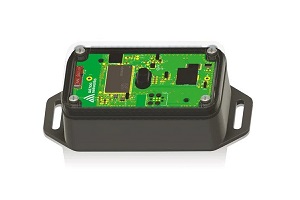German-based company adhoc networks has released a smart waste management solution capable of measuring fill levels in waste containers. This allows waste management businesses such as government bodies or private companies to better allocate rubbish collection resources and avoid overflow. The ‘adhoc smart waste’ device uses built-in optical sensors to monitor the fill levels of a variety of different containers, including underground waste systems which present additional monitoring challenges through reduced visibility and increased storage volume.
The monitoring process is overseen by Nordic Semiconductor’s nRF9160 SiP, which then collates the data and sends it to the Cloud, using its multimode LTE-M/NB-IoT modem. Users can then view this information through the centralised web platform, manage waste container assets, as well as review current and historical data. The platform can also perform self-learning fill level prediction modelling and offers dynamic route simulation to optimise rubbish collection crew productivity.
Reducing CO2 emissions
“Our platform has been tailored so our customers can easily manage their container fleet and conduct dynamic routing based on fill levels,” says Christian Wedekind, senior product manager at adhoc networks. “This helps save resources and reduces CO2 emissions by only scheduling waste collection when containers are actually filled. With our solution, emissions in waste disposal businesses can be reduced by up to 40%.
“We also operate the whole solution for our customers, debug any problems remotely and keep everything running at all times. Therefore a 100% reliable connection provided by the nRF9160 SiP is crucial for our subscription business model.”
The product also includes a gyroscope for detecting collection events as well as a temperature sensor and optional humidity sensor, controlled by the nRF9160’s dedicated 64 MHz Arm Cortex-M33 application processor, with 1 MB Flash and 256 KB RAM.
Five year battery life
Powered by a single 3.6 V Li-Thionyl AA battery, the solution can operate for up to five years between battery replacement, thanks in part to the low power characteristics of the nRF9160 SiP. The SiP supports both PSM and eDRX power saving modes, which enables it to sleep for longer periods of time. For both LTE-M and NB-IoT the PSM floor current is as low as 2.7 µA, and with an eDRX interval of 655 s the average current is 6 µA for LTE-M and 9 µA for NB-IoT.
“Battery life was a very important factor for us as the product is designed to be used over a wide area on a large number of containers, meaning the less we have to change the battery, the better,” explains Michael Ebert, senior embedded developer at adhoc networks. “As such the extended lifetime enabled by the nRF9160 SiP was a major drawcard for us. We also loved that it is a single-chip solution, with excellent integration of features and functionality.
“Thanks to Nordic’s application samples and SDK we didn’t have to worry about the connectivity part of the solution – it just worked. This meant that we could focus on our sensor integration and main product features.
“The Nordic support has been excellent, and we were able get any assistance we needed very quickly.”
Comment on this article below or via Twitter: @IoTNow_OR @jcIoTnow







